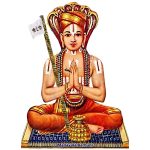Srimathe Rangaramanuja Mahadesikaya Namaha
Srimathe Sri Varaha Mahadesikaya Namaha
Sri Velukkudi Krishnan Swamy Thiruvadigaley Sharanam
Sri:
Saved this around 23-Jun-2017 from
http://sriramanujar.tripod.com/tVsv.html
Some I agree & some I don’t on personal front.
There are about 18 such points of differences with varying degrees of insignificance as not to deserve a discussion at all. Still, being on the subject, we shall briefly allude to a few of them by way of illustration and without comment
1. Regarding Lord’s mercy. Next to the Caste mark, this probably is the only other difference most people are aware of
Vadakalai View
Some positive gesture is necessary on the part of the jeevatma to deserve the grace of God, because He can be deemed partial if He grants Moksha to all both deserving and undeserving.
Tenkalai View
Lord’s grace is spontaneous. He can grant Moksha to anyone he likes.
2. Regarding the status of Lakshmi (i) as to her being the means (ii) as to her being infinite (iii) as to her being Paramatma
Vadakalai View
(i) She is the means for attaining salvation as much as the Lord Himself and also has the role of a mediator ( Purushakara)(ii) She is infinite in nature (Vibhu) like the Lord Himself(iii) She is also Paramatma as much as the Lord Himself
Tenkalai View
(i) Do not accept this position though they accept her recommendatory role as held by Vadakalais(ii) She is atomic in nature like other Jeevatmas(iii) She is a Jeevatma like any of us.
3. Regarding Kaivalya
Vadakalai View
(i) Kaivalya is inferior to Paramapada(ii) Kaivalya is not eternal(iii) Kaivalya is situated Outside Paramapada
Tenkalai View
(i) Accepted(ii) Kaivalya is eternal(iii) Kaivalya is within Paramapada but in its outermost parts.
4. Regarding the means of Bhakti and Prapatti
Vadakalai View
Accept both as the direct means but Bhakti is more difficult and dilatory while Prapatti is easy and immediate
Tenkalai View
Do not accept any means because Jeevatma is so utterly dependent as to be incapable of adopting either Bhakti or Prapatti as a means.
5. Regarding Prapatti
Vadakalai View
Prapatti has to be a positive specific act of surrender by the jeevatma to the Paramatma
Tenkalai View
No positive, specific act is necessary. All that is required is
(i) the knowledge of the Svarupa of the Jeevatma and(ii) mental acceptance of the Lord’s grace in granting salvation
6. Regarding sins
Vadakalai View
When a jeeva surrenders, the Lord forgives the sins committed by the jeevatma and grants Moksha.
Tenkalai View
The sins of a jeevatma is a source of joy for the Lord who relishes the same like a cow licking off the dirt on the body of its calf
7. Regarding performance of Compulsory duties like Sandhyavandanam
Vadakalai View
As compulsory duties are laid down by the Sastras which are the Lord’s commandments, non- performance will tantamount to transgression of His commands (Ajna adhilangana) and will render the Prapanna liable for punishment
Tenkalai View
To a highly evolved soul, non- performance of the compulsory duties is not an offence. But, they should continue to do them more for setting an example to the less evolved souls.
8. Regarding the interpretation of the words “Sarva Dharman Parityajya’ occurring in the Charama sloka
Vadakalai View
The Dharmas actually refer to the 32 Vidyas attaching to Bhaktiyoga which had already been given up by the jeeva due to incapacity and delay involved in observing them and the Lord offers to stand in their place
Tenkalai View
This is literally interpreted to mean ‘ First, give up your duties and then take refuge in the Lord’
9. Regarding the Lord’s grief at the suffering of the souls
Vadakalai View
One can have grief only when one cannot remove suffering of another. But, the Lord is capable of removing suffering. So, there is no need for Him to grieve. As Sri Rama , He shows to the World how a human would feel and how one should react on seeing the misery of others.
Tenkalai View
They hold that the Lord actually feels sorry on seeing the sufferings of souls and cite examples from Srimad Ramayana where Sri Rama is depicted as grieving over the misery of others.
10. Regarding the Lord’s being also atomic as well as gigantic in size as mentioned in the Vedas.
Vadakalai View
He is smaller than the atom in beings that are atomic in size. This is called ‘Antar Vyapti’ ( Immanence). He is also greater than the greatest in the sense He pervades and surrounds everything. This is called ‘ Bahir Vyapti’. ( Transcendence)
Tenkalai View
His being atomic in atoms and enveloping even the biggest are all
done by what is known as ‘Agatitha Ghatana Saamartya’- Special powers enabling accomplishment of even the impossible.
Dasanudasan


